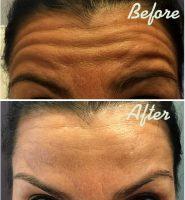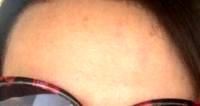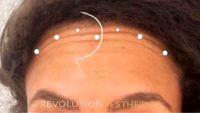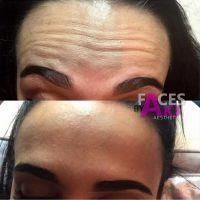How Much Botox Do I Need For My Forehead?
Most patients will require anywhere from 10-20 Botox units to treat horizontal forehead lines. Keep in mind that this amount does not include the glabella “11” lines or any other areas. And each patient is different, so the total amount of required units may vary from patient to patient.
Additionally, patients should know that treating ONLY deep horizontal lines in the forehead has the potential to drop the brows, leading to a tired appearance and worsening of any upper eyelid heaviness that may exist.
Treating the glabella and the crow’s feet prior to (or at the same time as) treating the horizontal forehead lines may help to offset any brow drop. Always see an expert physician injector for Botox injections. (Matthew Richardson, MD, Frisco Facial Plastic Surgeon)

Horizontal Lines Across The Forehead Are Usually Injected In Conjunction With The Glabella Lines
Botox Injection of The Forehead: It’s Not Just About The Number Of Units
There is no absolute number of units of Botox a patient should receive to treat a specific number of forehead wrinkles. In our practice, the range of units that we use can vary from four to thirty-four, but this does not really tell the story.
Not merely the dosage of Botox, but the placement and number of injections in which muscles, and which portions of the muscles, needs to be individualized to the anatomy and aesthetic goals of each patient.
The treatment of forehead wrinkles with Botox injections is really a double-edged sword. Many patients have the transverse wrinkling of the forehead that they see, because they have brow ptosis, i.e., the soft tissue of the brow has descended to some degree, and the patients need to fire their frontalis muscles on a virtually continuous basis to elevate the overlying soft tissue, so that their field of vision, especially on upward gaze, is not diminished.
This activity causes wrinkles to form in a direction perpendicular to the vector of pull of the paired frontalis muscles. However, when a physician injects Botox into the frontalis muscles underlying these wrinkles, he is causing a weakening of those muscles, and thus a diminution of their ability to elevate the ptotic soft tissue of the brow.
Inject too much Botox in the wrong places, and you will have actually exacerbated, or, in some cases, caused, brow ptosis in your patient. In our practice, we make a point of first supporting the brow by injecting Botox in the periorbital muscles whose vectors of pull naturally counteract that of the frontalis muscle.
Once we have done this, we are extremely deliberate, precise, and conservative, in both the dosing, and the placement, of Botox injections in the forehead.
Remember too, that in addition to causing ptosis of the brow, it is also possible to cause ptosis of the upper eyelid by injecting Botox in the wrong anatomic location, or at the wrong depth, in the inferior portion of the forehead.

The Exact Number Of Units For Full Treatment Is Customized For Each Individual Person
Botox injection of the forehead is an extremely useful tool to achieve subtle improvements in the upper third of the face of both men and women.
But, like any powerful tool, its indications, limitations, complications and side-effects must be well-understood by a physician who is experienced with the procedure, knows how to avoid the problems that can result, and is prepared to address any possible untoward effects that might arise. (Peter Lee, MD, FACS, Los Angeles Plastic Surgeon)
Botox is very effective as softening dynamic wrinkles (creases in the skin only visible when muscles are contracting), but less effective in smoothening static wrinkles.
If your forehead wrinkles do not fade with Botox, you may want to consider filler beneath the skin to completely erase these wrinkles. (Joseph A. Eviatar, MD, FACS, New York Oculoplastic Surgeon)

The Optimal Amount Of BOTOX Without Over-treating An Area
Botox is an excellent anti-wrinkle treatment and when used correctly by an experienced medical aesthetic practitioner can naturally rejuvenate and freshen the face whilst retaining the natural facial expressions. Deep forehead lines occur in someone who uses their frontalis (forehead muscle) a lot.
Over treating this area to smooth out the lines can have devastating cosmetic results, namely, the brows can drop (ptosis). So do not be tempted to aim for a flat forehead within one treatment.
Instead by placing micro-injections of Botox (“baby Botox”) you can control how the muscles work together to reduce the wrinkles without compromising brow position.
As always, the best advice is to seek a highly qualified and dedicated aesthetic medical practitioner who can guide you towards the most appropriate options and results for you. (Tracy Mountford, MBBS, London Physician)

The Right Amount Of BOTOX Is Not The Same For Everyone
Botox dose for the forehead
Botox is a purified protein used to address wrinkles associated with facial expression. It is difficult to make an assessment without a formal exam. However the forehead is a common area for treatment with Botox.
The forehead contains two muscle groups. One leads to the appearance of horizontal wrinkles that get deeper when one raises the brows. Typically anywhere from 8 to 20 units are used in this area based on the size and bulk of the muscle.
Also men generally require a higher dose than woman. The other muscle group leads to the appearance of vertical lines seen between the brow which get deeper when one frowns. The pivotal studies demonstrated that when 20 units are used in this area peak effects are seen at 14 days and most people enjoy their results for 3-4 months.

Botox Injections Units Needed To Treat Forehead Lines
Please consult with a doctor for specific recommendations. (Alex Eshaghian, MD, PhD, Encino Physician)
The number of units of Botox one needs depends on a number of factors. Namely, the strength of the frontalis (forehead) muscle, the number and depth of wrinkles, and the general expectations of the patient.
I often tell my patients that the goal of Botox is to soften the lines of the forehead, not eradicate them completely. This is because too much Botox in the forehead area can cause a lowering of the eyebrow, and lead to a frozen appearance on the forehead. (Mariam Cappiello, MD, Chestnut Hill Anesthesiologist)
Botox units for forehead lines
Here are a few pointers:
1. The dosage is variable depending on desired results and muscle strength. Your practitioner should provide you with information on this during consultation.

The Goal With BOTOX Treatment Is To Diminish Wrinkles
2. On average units for forehead injection, around 10 units are required. (Rupert Critchley, MD, MRCGP, London Physician)
Botox for Forehead Lines
Care must be taken in dealing with forehead lines. They should be treated gingerly at first, because they form in response to your desire to open the eyes, and are most pronounced in those who need or want the most eye opening.
This group includes those clients who would do well with a blepharoplasty, to properly reveal the eye. So, overtreatment is to be avoided here. In most cases, I solve this problem by beginning with “light” treatment and gradually increasing the level of paralysis as it is tolerated.
One can always add Botox, but you cannot remove it. See an experienced injector, and make your feelings known, so that you get what you want safely. (Gregg Kennedy, MD, Buford Physician)
Forehead wrinkle treatment dosage
The dose will vary depending on the degree of muscularity. Men usually require more. I usually begin with 10 units in women and 20-40 units in men. Care must be exercised not to treat too close to the orbital rim so as not to drop the brow.
I prefer to treat the brow depressors at the same time to even out the muscular pull in both directions. Always watch for preexisting brow ptosis (droopiness). If present there is a danger of worsening this condition when treating the forehead muscle (frontalis).
When done properly there is little likelihood of a problem. (Maurice M. Vick, Jr., MD, Baton Rouge Urologist)
Every patient is a different case.
In most medical procedures, Botox included, it is always a different case for every patient, but first you need to keep your expectations reasonable
This is in terms of what Botox will be able to do for you. Regrettably, having forehead Botox injections would be a difficult circumstance brought about by conflicting conditions. Individuals with deep forehead lines almost always utilize a forehead muscle called frontalis muscle to help elevate the brows when talking and at times even to help them see clearer.
If these lines are smoothen, the frontalis muscle could weaken a lot. This might have side effects such as droopy eyebrows or flat forehead – two unsightly things to see in your face. It is always recommended to first try to provide support to the eyebrows with a Botox brow-lift.
It may bring a secondary effect on the frontalis muscle making it more relaxed in certain areas This will then reduce the wrinkles in a more natural way and without the risk of drooping the eyebrows.
As soon as this takes effect, a reduced number of Botox units will be strategically scattered in the forehead location. This softens the wrinkles more without the risk of weighing the brows down. Essentially, there will be different units for every person’s case.
It would be better to personally seek professional opinion about this. (Robert W. Sheffield, MD, Santa Barbara Plastic Surgeon)
